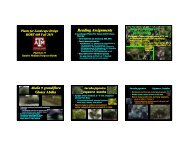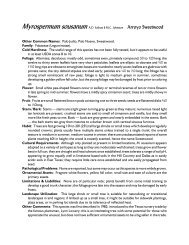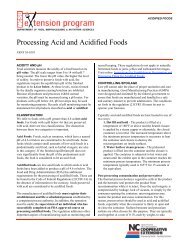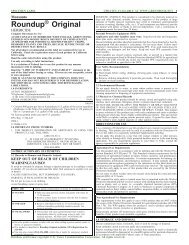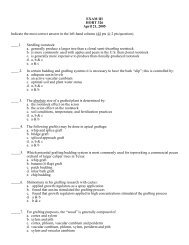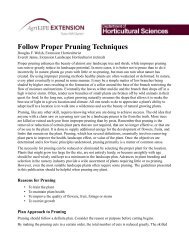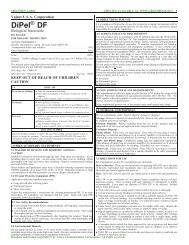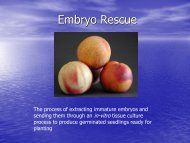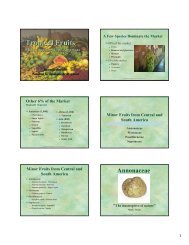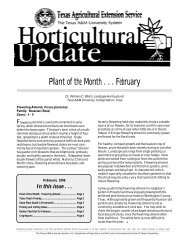Guide to PAS 2050 How to assess the carbon ... - Aggie Horticulture
Guide to PAS 2050 How to assess the carbon ... - Aggie Horticulture
Guide to PAS 2050 How to assess the carbon ... - Aggie Horticulture
You also want an ePaper? Increase the reach of your titles
YUMPU automatically turns print PDFs into web optimized ePapers that Google loves.
20<br />
Section II: Calculating product <strong>carbon</strong> footprints<br />
For full compliance with <strong>PAS</strong> <strong>2050</strong>, it is necessary <strong>to</strong><br />
disclose <strong>the</strong> basis of any use phase calculation<br />
(data sources, assumptions, etc.) – see <strong>PAS</strong> <strong>2050</strong><br />
Section 6.4.8.<br />
Records<br />
<strong>PAS</strong> <strong>2050</strong> requires that detailed records be kept of all<br />
data sources and any assumptions that are used <strong>to</strong><br />
carry out <strong>the</strong> emissions <strong>assess</strong>ment. To communicate<br />
<strong>the</strong> footprint externally, details of boundaries, use<br />
profile and all data sources should be disclosed <strong>to</strong><br />
ease transparency.<br />
Armed with sufficient data, now it is time <strong>to</strong> put it all<br />
<strong>to</strong>ge<strong>the</strong>r and calculate <strong>the</strong> <strong>carbon</strong> footprint of <strong>the</strong><br />
product (see Communicating <strong>the</strong> footprint and claiming<br />
reductions).<br />
Step 4: Calculating <strong>the</strong><br />
footprint<br />
The equation for product <strong>carbon</strong> footprinting is <strong>the</strong><br />
sum of all materials, energy and waste across all<br />
activities in a product’s life cycle multiplied by <strong>the</strong>ir<br />
emission fac<strong>to</strong>rs. The calculation itself simply involves<br />
multiplying <strong>the</strong> activity data by <strong>the</strong> appropriate<br />
emission fac<strong>to</strong>rs.<br />
Carbon footprint of a given activity =<br />
Activity data (mass/volume/kWh/km) ×<br />
Emission fac<strong>to</strong>r (CO 2<br />
e per unit)<br />
Mass balance<br />
The quantification of <strong>the</strong> <strong>to</strong>tal amount of all materials<br />
in<strong>to</strong> and out of a process is referred <strong>to</strong> as ‘mass<br />
balance’. The mass balance step provides<br />
confirmation that all materials have been fully<br />
accounted for and no streams are missing.<br />
The fundamental concept is that <strong>to</strong>tal mass flowing<br />
in<strong>to</strong> a process should equal <strong>to</strong>tal mass flowing out. In<br />
practice, it is a useful way <strong>to</strong> identify previously hidden<br />
waste streams: if <strong>the</strong> mass coming out of a process is<br />
less than <strong>the</strong> combined mass of <strong>the</strong> inputs, <strong>the</strong>n some<br />
o<strong>the</strong>r stream – most likely waste – must be leaving <strong>the</strong><br />
process <strong>to</strong>o. Note that for some complex natural<br />
systems, like agriculture, mass balance may not be<br />
practical or relevant.<br />
Services note: The services equivalent of a mass<br />
balance calculation is called an activity-based<br />
<strong>assess</strong>ment. For a given activity, all processes and<br />
materials flowing in<strong>to</strong> and out of that activity stage<br />
must be analysed for <strong>the</strong>ir GHG emissions.<br />
For example, a mass balance check on <strong>the</strong> flour<br />
production stage for croissants would be as shown<br />
opposite.<br />
It is easiest <strong>to</strong> calculate mass balances while <strong>the</strong> data<br />
is being collected. First work backwards from <strong>the</strong> point<br />
of purchase: all materials, energy and direct emissions<br />
<strong>to</strong> produce a unit should be included, and all <strong>the</strong><br />
mass accounted for. Then use a similar process <strong>to</strong><br />
ensure <strong>the</strong> full mass of <strong>the</strong> product is captured in <strong>the</strong><br />
use and disposal phases.<br />
Once GHG emissions are calculated for each activity,<br />
convert <strong>to</strong> CO 2<br />
e using <strong>the</strong> relevant global warming<br />
potential (GWP) fac<strong>to</strong>rs described in <strong>PAS</strong> <strong>2050</strong> Table A.1<br />
Calculating <strong>the</strong> <strong>carbon</strong> footprint normally requires a<br />
‘mass balance’ <strong>to</strong> ensure all input, output and waste<br />
streams are accounted for.<br />
Footprint calculation<br />
The actual calculation involves multiple steps, which<br />
are shown in <strong>the</strong> croissants example. For reference,<br />
each step is numbered in <strong>the</strong> process map opposite<br />
and corresponds <strong>to</strong> a discrete part of <strong>the</strong> detailed<br />
calculation diagram (pages 22–26) and <strong>the</strong> worked<br />
example in Appendix III.




